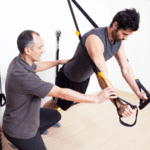
Breathing; “the process of taking air into and expelling it from the lungs”. But oh, it is so much more than that! Breathing involves movement of muscles, organs, and joints; that is if you are doing it correctly. Should I belly breathe? Chest breathe? Am I supposed to hold my abdominals tight all day? I get these questions all the time! Today we are going to discuss the “normal” way to breathe. What’s right and what is wrong?
We need to start thinking of breathing as one of the most important foundations of our body’s musculoskeletal system. Correct breathing allows for strengthening and mobility of deep muscles layers, small joint mobility, and proper function of the core and pelvic floor.
What happens when we take a breath? As we inhale the diaphragm contracts, dropping, to pull air into the lungs. As the lungs fill up with air, the added pressure has to go somewhere. Where do we want this pressure to go? Ideally we want the pressure to be dispersed 360 degrees. We want the diaphragm to drop and the pressure to move toward the abdominal area, but we don’t want ALL the pressure to go into the belly. We want the lower rib cage to flare out some sending some of that pressure lateral. This allows for more muscle action and for the joints connecting the ribs to the spine to move, allowing for some of that pressure to move to the back contracting the posterior side of the diaphragm.
What happens if we just belly breathe or just chest breathe? If we are only bringing air into the belly this puts a lot of pressure on our linea alba, which is not good if we have been diagnosed with a diastasis recti. This also limits the movement of the rib cage lessening the movement at the spine. This could lead to stiffness and pain in the mid back region. If we are only chest breathing we could get a tight pelvic floor or abdominal area from little movement of the diaphragm as well as over use of our respiratory accessory muscles causing neck stiffness and pain. This can cause numbness or tingling in the fingers (especially in pregnant women). Breathing correctly can help us avoid neck pain, thoracic pain, pelvic floor tightness, distended abdominals and even help us resolve psoas pain (tight hip flexors). Breathing correctly can also help us heal a diastasis recti!
There are many different exercises you can do to help improve your breathing technique. Here are a couple exercises to help focus the pressure 360 degrees.

1. To practice getting your ribs to expand, you can lie on your side with your knees and hips bent making it harder to belly breath. Put your hand on the side of your rib cage and breathe down. Feel your ribs expand with your hands as you inhale trying to get some of the pressure to move to the side. Exhale all your air out and then more!
To practice getting your ribs to expand, you can lie on your side with your knees and hips bent making it harder to belly breath. Put your hand on the side of your rib cage and breathe down. Feel your ribs expand with your hands as you inhale trying to get some of the pressure to move to the side. Exhale all your air out and then more!

2. To practice getting your back to expand. Sit in a squatted position on a block. Wrap your arms around your legs and inhale focusing on expanding through the back of the diaphragm. Be careful not to let all the air go down into the pelvic floor. If your back is very stiff this may be difficult.
If these exercises are difficult for you or you need help learning how to properly breathe seek out a pelvic floor physical therapist!
Happy Breathing!



